Abstract
1.Hypercapnic ventilatory responses of thirty-five full term infants aged 1-7 days were evaluated, and the characteristics and incidence of augmented breaths were determined. 2. According to the inspiratory airflow profile and tidal volume (VT), augmented breaths were categorized as 'type A' (biphasic, VT > or = 2 x control VT), or 'type M' (multiphasic, VT < 2 x control VT). 3. Steady-state inhalation of 2-4% CO2 resulted in a 3-fold increase in the frequency of augmented breaths after 8 min; 80 s rebreathing a mixture containing 5-6% CO2 resulted in a 20-fold increase in the frequency of these breaths. 4. During eupnoea, 85% of spontaneously occurring augmented breaths were type A. With increasing respiratory drive, there was a disproportionate increase in type M compared with type A breaths: after 80 s rebreathing, 86% of augmented breaths were type M and only 14% were type A. 5. These findings indicate that the hypercapnic hyperpnoea facilitates an inspiration-augmenting reflex in newborn infants. The significance of type M breaths is unclear; they appear to be characteristic of the newborn, and may represent the response of an immature respiratory system to load.
Full text
PDF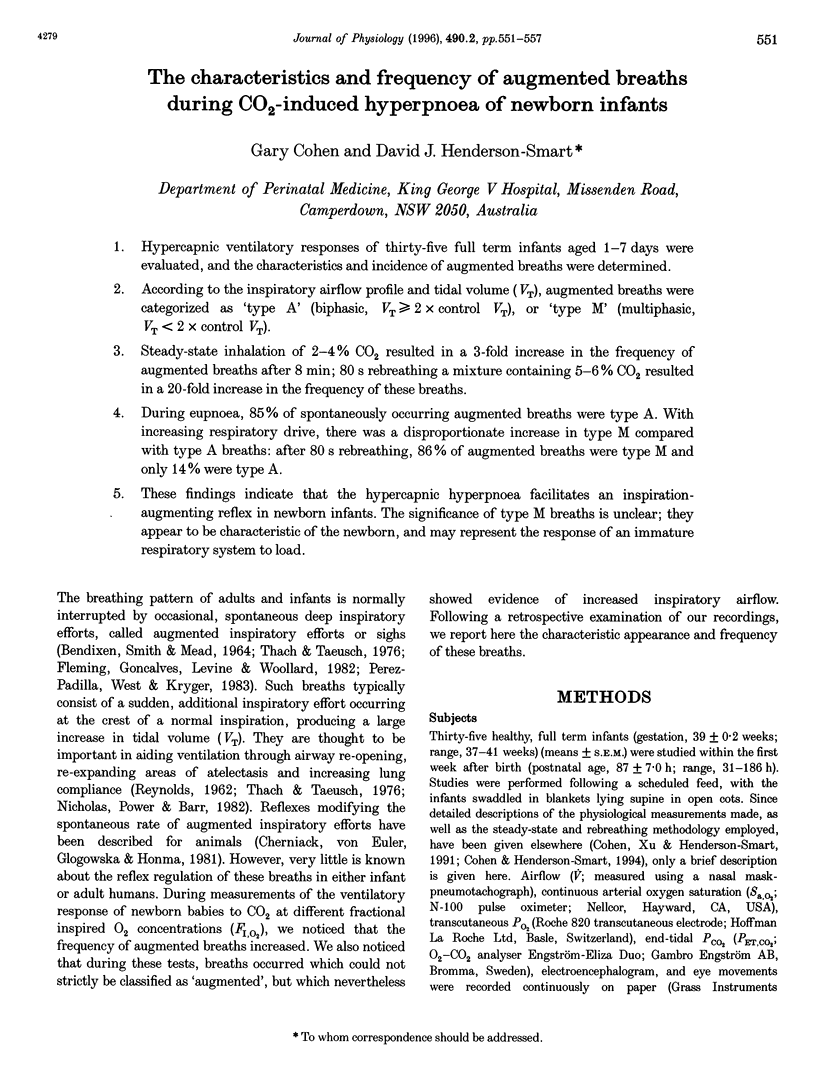
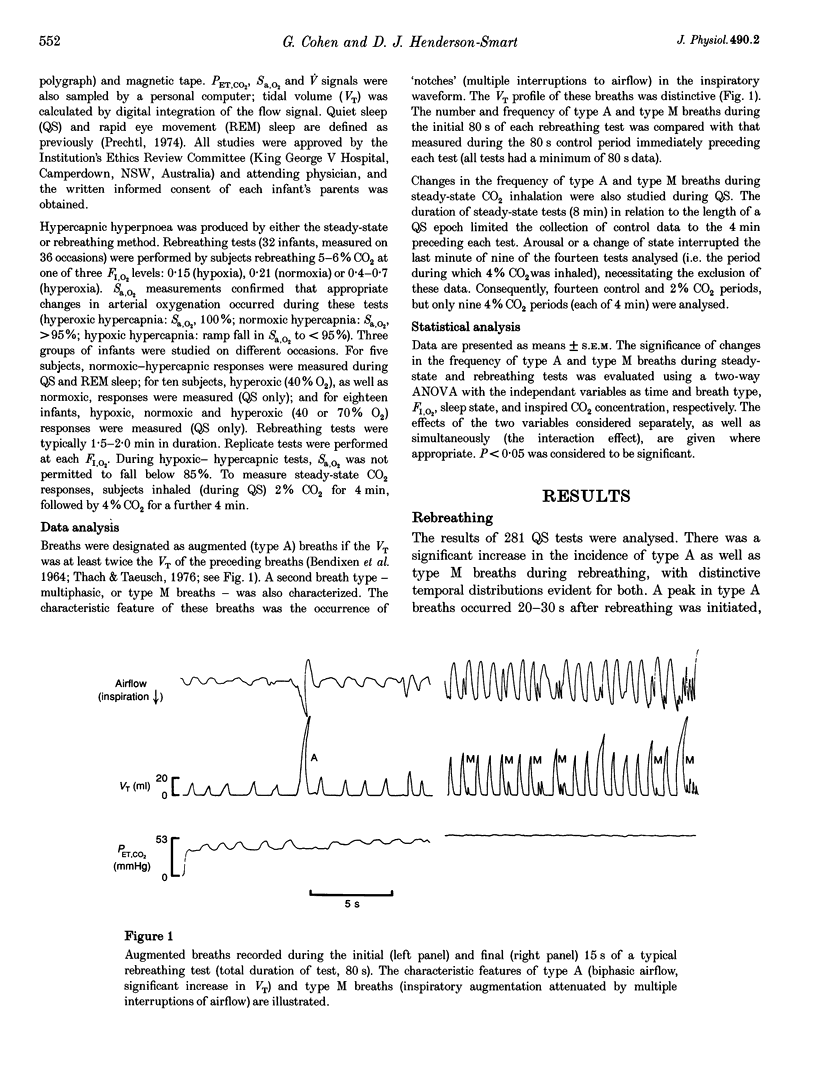
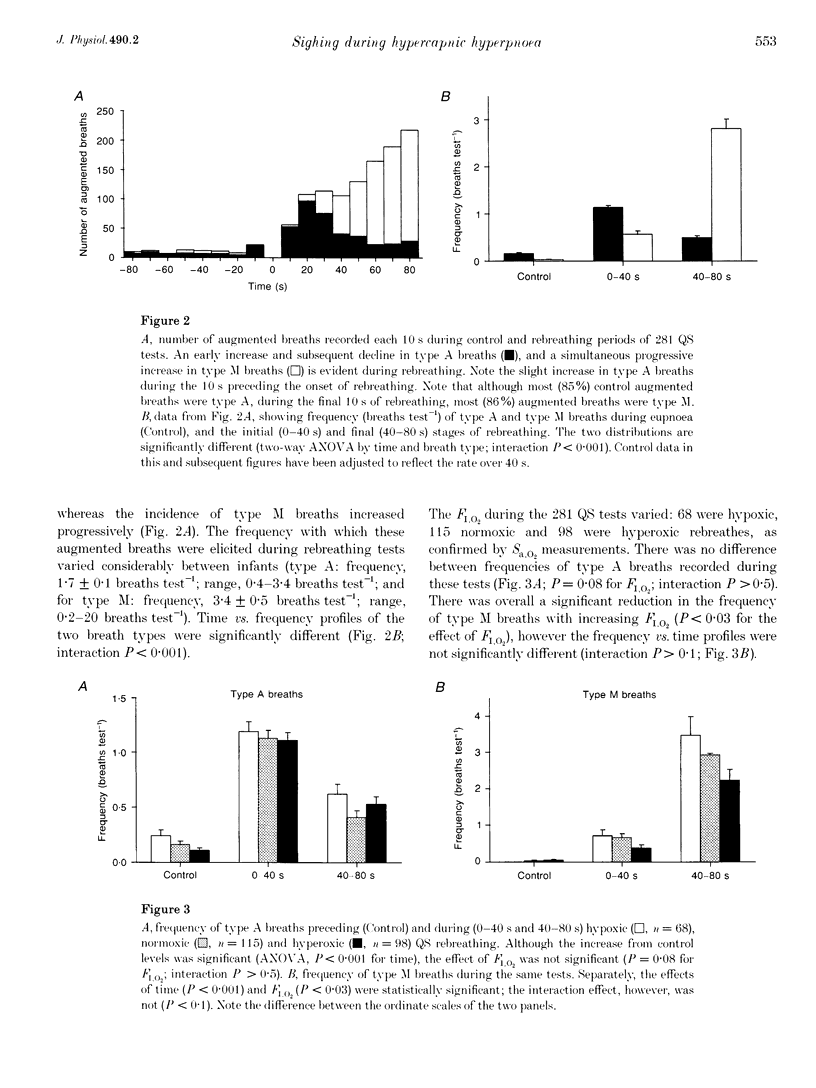
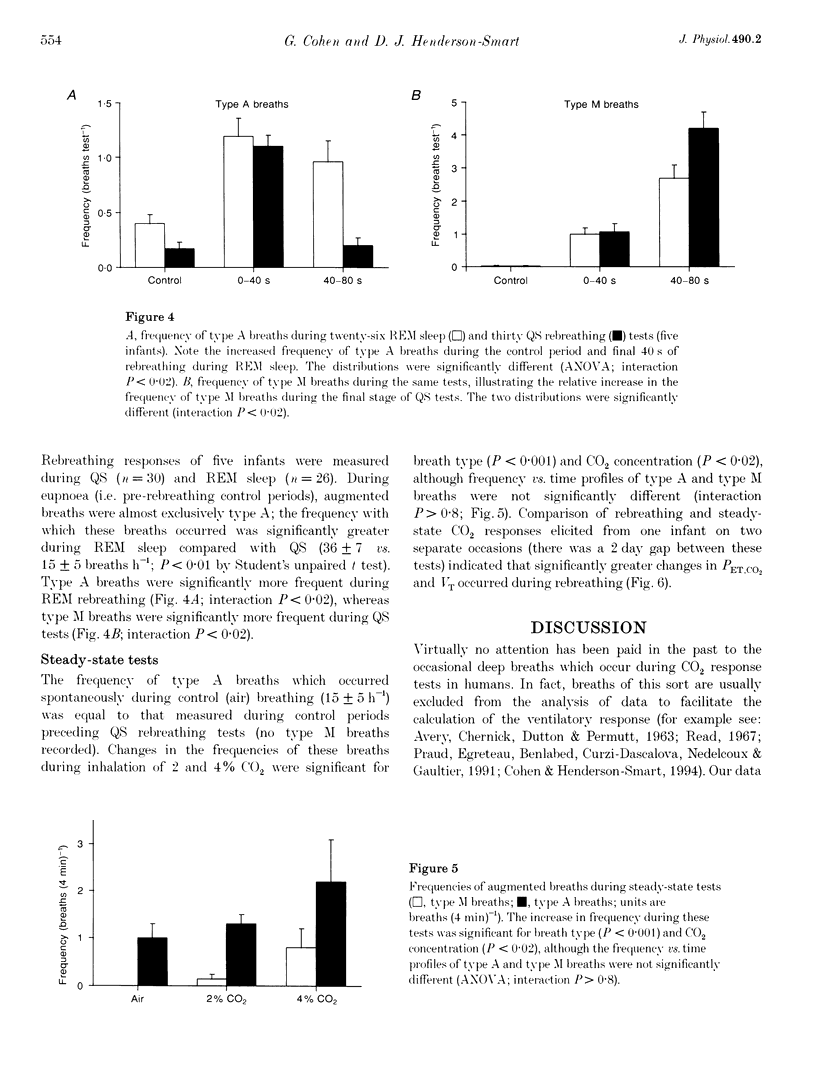
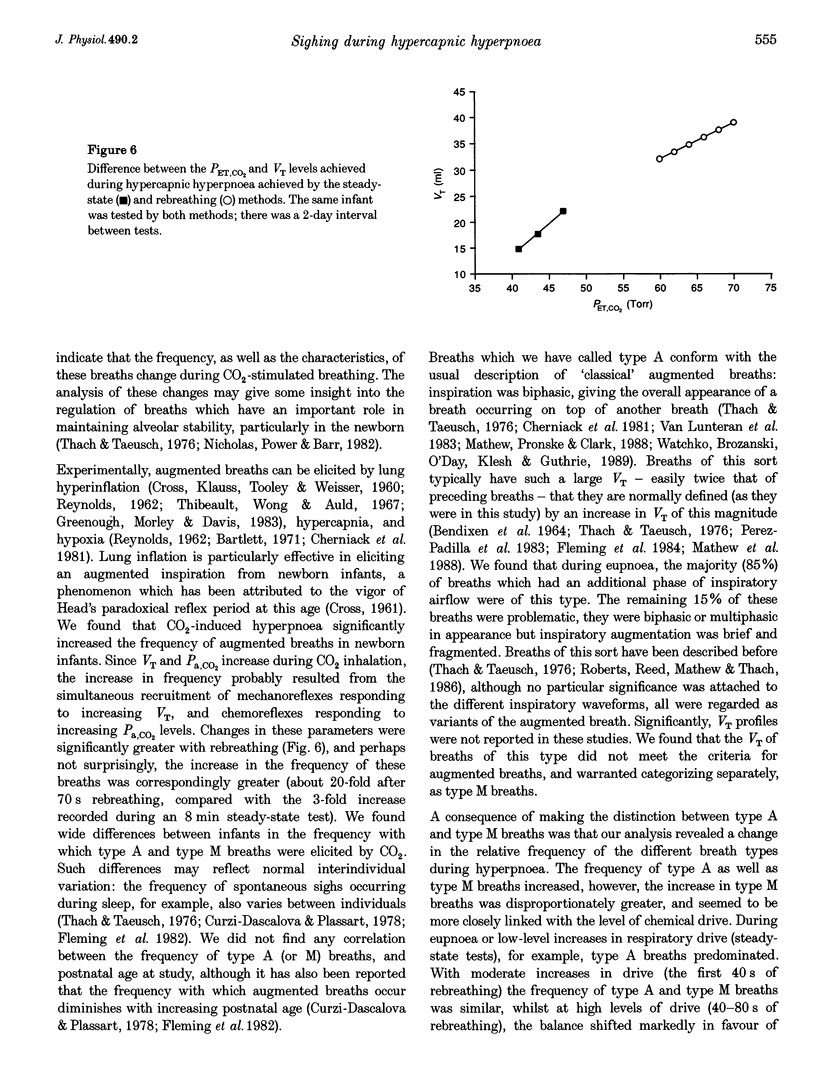
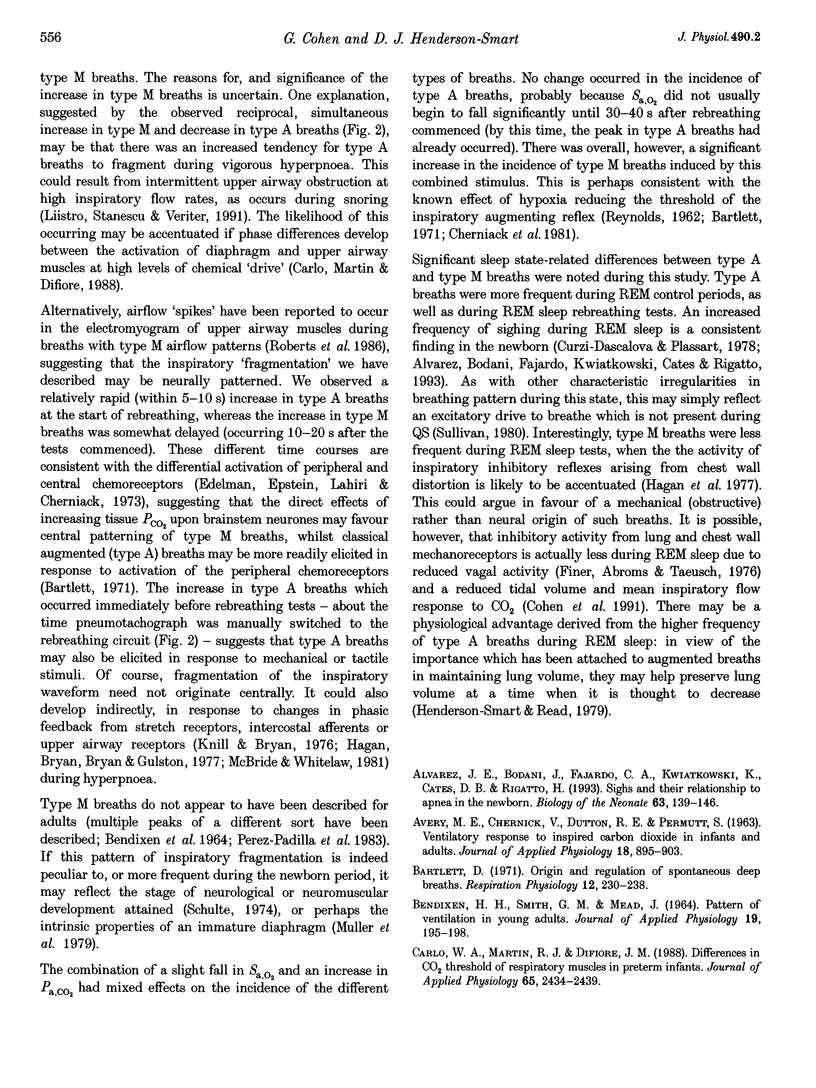
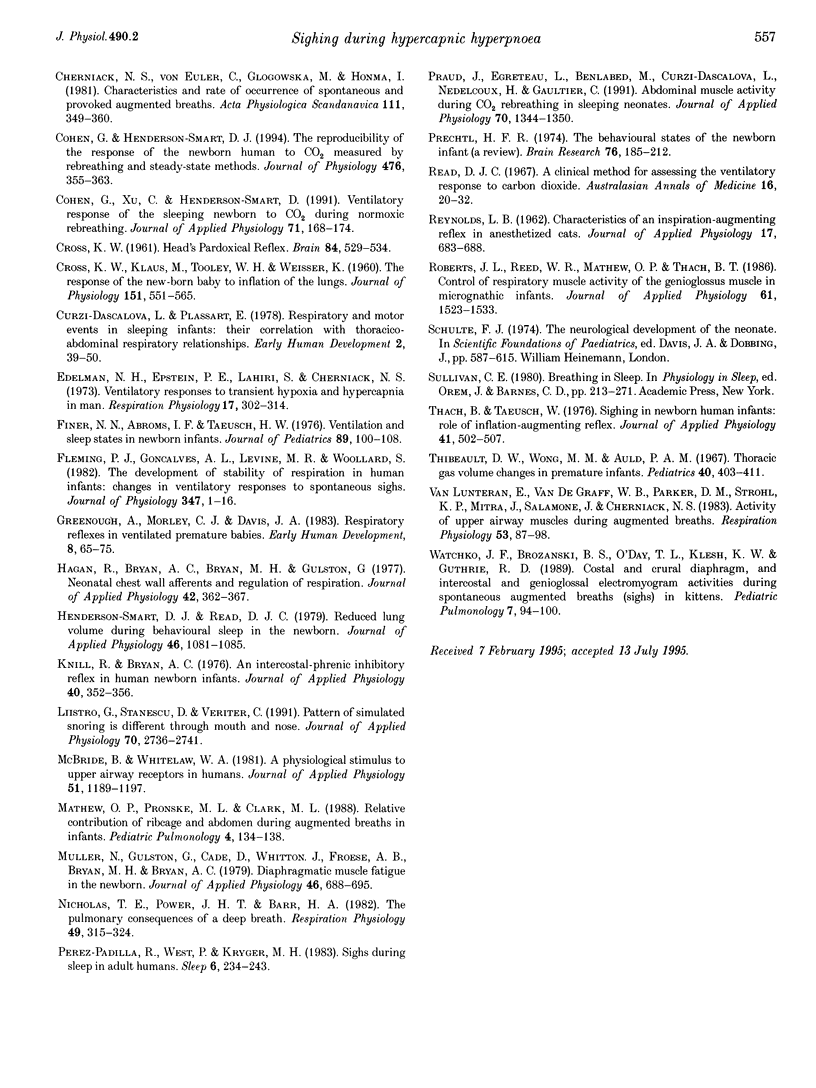
Selected References
These references are in PubMed. This may not be the complete list of references from this article.
- AVERY M. E., CHERNICK V., DUTTON R. E., PERMUTT S. VENTILATORY RESPONSE TO INSPIRED CARBON DIOXIDE IN INFANTS AND ADULTS. J Appl Physiol. 1963 Sep;18:895–903. doi: 10.1152/jappl.1963.18.5.895. [DOI] [PubMed] [Google Scholar]
- Alvarez J. E., Bodani J., Fajardo C. A., Kwiatkowski K., Cates D. B., Rigatto H. Sighs and their relationship to apnea in the newborn infant. Biol Neonate. 1993;63(3):139–146. doi: 10.1159/000243923. [DOI] [PubMed] [Google Scholar]
- Bartlett D., Jr Origin and regulation of spontaneous deep breaths. Respir Physiol. 1971 Jun;12(2):230–238. doi: 10.1016/0034-5687(71)90055-7. [DOI] [PubMed] [Google Scholar]
- CROSS K. W., KLAUS M., TOOLEY W. H., WEISSER K. The response of the new-born baby to inflation of the lungs. J Physiol. 1960 Jun;151:551–565. doi: 10.1113/jphysiol.1960.sp006459. [DOI] [PMC free article] [PubMed] [Google Scholar]
- Carlo W. A., Martin R. J., Difiore J. M. Differences in CO2 threshold of respiratory muscles in preterm infants. J Appl Physiol (1985) 1988 Dec;65(6):2434–2439. doi: 10.1152/jappl.1988.65.6.2434. [DOI] [PubMed] [Google Scholar]
- Cherniack N. S., von Euler C., Głogowska M., Homma I. Characteristics and rate of occurrence of spontaneous and provoked augmented breaths. Acta Physiol Scand. 1981 Mar;111(3):349–360. doi: 10.1111/j.1748-1716.1981.tb06747.x. [DOI] [PubMed] [Google Scholar]
- Cohen G., Henderson-Smart D. J. The reproducibility of the response of the human newborn to CO2 measured by rebreathing and steady-state methods. J Physiol. 1994 Apr 15;476(2):355–363. doi: 10.1113/jphysiol.1994.sp020137. [DOI] [PMC free article] [PubMed] [Google Scholar]
- Cohen G., Xu C., Henderson-Smart D. Ventilatory response of the sleeping newborn to CO2 during normoxic rebreathing. J Appl Physiol (1985) 1991 Jul;71(1):168–174. doi: 10.1152/jappl.1991.71.1.168. [DOI] [PubMed] [Google Scholar]
- Curzi-Dascalova L., Plassart E. Respiratory and motor events in sleeping infants: their correlation with thoracico-abdominal respiratory relationships. Early Hum Dev. 1978 Apr;2(1):39–50. doi: 10.1016/0378-3782(78)90051-8. [DOI] [PubMed] [Google Scholar]
- Edelman N. H., Epstein P. E., Lahiri S., Cherniack N. S. Ventilatory responses to transient hypoxia and hypercapnia in man. Respir Physiol. 1973 Apr;17(3):302–314. doi: 10.1016/0034-5687(73)90005-4. [DOI] [PubMed] [Google Scholar]
- Finer N. N., Abroms I. F., Taeusch H. W., Jr Ventilation and sleep states in newborn infants. J Pediatr. 1976 Jul;89(1):100–108. doi: 10.1016/s0022-3476(76)80941-9. [DOI] [PubMed] [Google Scholar]
- Fleming P. J., Goncalves A. L., Levine M. R., Woollard S. The development of stability of respiration in human infants: changes in ventilatory responses to spontaneous sighs. J Physiol. 1984 Feb;347:1–16. doi: 10.1113/jphysiol.1984.sp015049. [DOI] [PMC free article] [PubMed] [Google Scholar]
- Greenough A., Morley C. J., Davis J. A. Respiratory reflexes in ventilated premature babies. Early Hum Dev. 1983 Mar;8(1):65–75. doi: 10.1016/0378-3782(83)90035-x. [DOI] [PubMed] [Google Scholar]
- Hagan R., Bryan A. C., Bryan M. H., Gulston G. Neonatal chest wall afferents and regulation of respiration. J Appl Physiol Respir Environ Exerc Physiol. 1977 Mar;42(3):362–367. doi: 10.1152/jappl.1977.42.3.362. [DOI] [PubMed] [Google Scholar]
- Henderson-Smart D. J., Read D. J. Reduced lung volume during behavioral active sleep in the newborn. J Appl Physiol Respir Environ Exerc Physiol. 1979 Jun;46(6):1081–1085. doi: 10.1152/jappl.1979.46.6.1081. [DOI] [PubMed] [Google Scholar]
- Knill R., Bryan A. C. An intercostal-phrenic inhibitory reflex in human newborn infants. J Appl Physiol. 1976 Mar;40(3):352–356. doi: 10.1152/jappl.1976.40.3.352. [DOI] [PubMed] [Google Scholar]
- Mathew O. P., Pronske M. L., Clark M. L. Relative contribution of ribcage and abdomen during augmented breaths in infants. Pediatr Pulmonol. 1988;4(3):134–138. doi: 10.1002/ppul.1950040303. [DOI] [PubMed] [Google Scholar]
- McBride B., Whitelaw W. A. A physiological stimulus to upper airway receptors in humans. J Appl Physiol Respir Environ Exerc Physiol. 1981 Nov;51(5):1189–1197. doi: 10.1152/jappl.1981.51.5.1189. [DOI] [PubMed] [Google Scholar]
- Muller N., Gulston G., Cade D., Whitton J., Froese A. B., Bryan M. H., Bryan A. C. Diaphragmatic muscle fatigue in the newborn. J Appl Physiol Respir Environ Exerc Physiol. 1979 Apr;46(4):688–695. doi: 10.1152/jappl.1979.46.4.688. [DOI] [PubMed] [Google Scholar]
- Perez-Padilla R., West P., Kryger M. H. Sighs during sleep in adult humans. Sleep. 1983;6(3):234–243. doi: 10.1093/sleep/6.3.234. [DOI] [PubMed] [Google Scholar]
- Praud J. P., Egreteau L., Benlabed M., Curzi-Dascalova L., Nedelcoux H., Gaultier C. Abdominal muscle activity during CO2 rebreathing in sleeping neonates. J Appl Physiol (1985) 1991 Mar;70(3):1344–1350. doi: 10.1152/jappl.1991.70.3.1344. [DOI] [PubMed] [Google Scholar]
- Prechtl H. F. The behavioural states of the newborn infant (a review). Brain Res. 1974 Aug 16;76(2):185–212. doi: 10.1016/0006-8993(74)90454-5. [DOI] [PubMed] [Google Scholar]
- REYNOLDS L. B., Jr Characteristics of an inspiration-augmenting reflex in anesthetized cats. J Appl Physiol. 1962 Jul;17:683–688. doi: 10.1152/jappl.1962.17.4.683. [DOI] [PubMed] [Google Scholar]
- Read D. J. A clinical method for assessing the ventilatory response to carbon dioxide. Australas Ann Med. 1967 Feb;16(1):20–32. doi: 10.1111/imj.1967.16.1.20. [DOI] [PubMed] [Google Scholar]
- Roberts J. L., Reed W. R., Mathew O. P., Thach B. T. Control of respiratory activity of the genioglossus muscle in micrognathic infants. J Appl Physiol (1985) 1986 Oct;61(4):1523–1533. doi: 10.1152/jappl.1986.61.4.1523. [DOI] [PubMed] [Google Scholar]
- Thach B. T., Taeusch H. W., Jr Sighing in newborn human infants: role of inflation-augmenting reflex. J Appl Physiol. 1976 Oct;41(4):502–507. doi: 10.1152/jappl.1976.41.4.502. [DOI] [PubMed] [Google Scholar]
- Thibeault D. W., Wong M. M., Auld P. A. Thoracic gas volume changes in premature infants. Pediatrics. 1967 Sep;40(3):403–411. [PubMed] [Google Scholar]
- Van Lunteren E., Van de Graaff W. B., Parker D. M., Strohl K. P., Mitra J., Salamone J., Cherniack N. S. Activity of upper airway muscles during augmented breaths. Respir Physiol. 1983 Jul;53(1):87–98. doi: 10.1016/0034-5687(83)90018-x. [DOI] [PubMed] [Google Scholar]
- Watchko J. F., Brozanski B. S., O'Day T. L., Klesh K. W., Guthrie R. D. Costal and crural diaphragm, and intercostal and genioglossal electromyogram activities during spontaneous augmented breaths (sighs) in kittens. Pediatr Pulmonol. 1989;7(2):94–100. doi: 10.1002/ppul.1950070208. [DOI] [PubMed] [Google Scholar]


